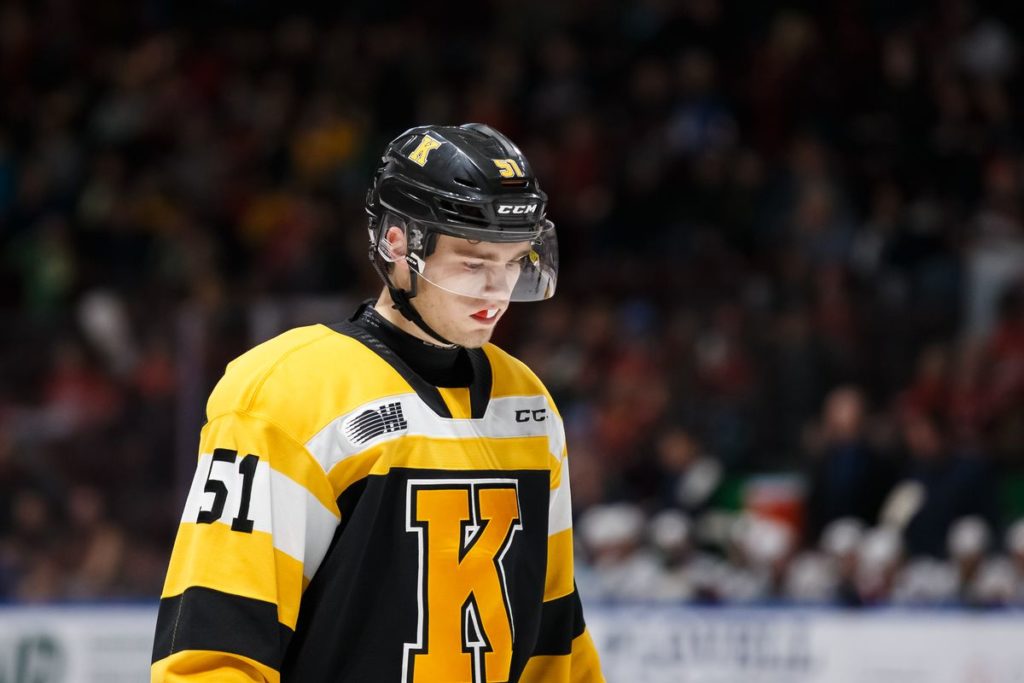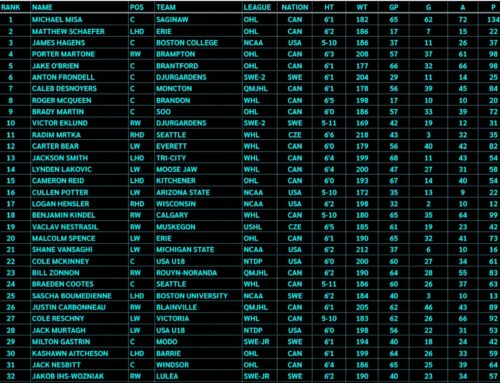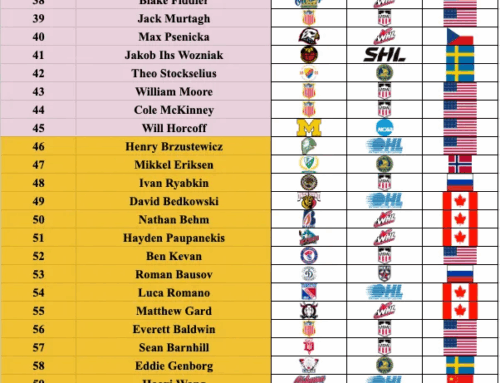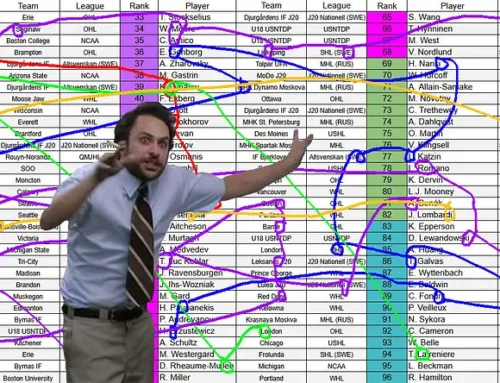Exceptions to the Rule: John Tavares and Shane Wright
Tony Ferrari
2020-03-25
‘Exceptional Status’ in the CHL has been given out just six times since it first became a reality in 2005. The Western Hockey League has never granted the exemption and the QMJHL has only done so once with Joe Veleno. The Ontario Hockey League has granted the exemption to four players – John Tavares, Aaron Ekblad, Connor McDavid and Sean Day – prior to this season. This past season, Shane Wright was granted ‘Exceptional Status’ in the OHL and despite a mixed bag recently among the players who have been given the exemption, Wright did not disappoint. Prior to the season being but short, he was on pace for 73 points, coming within just a few points of Tavares record for players granted the status.
Exceptional Status History
Let’s start with a brief history of how each case turned out and then we will take a deeper look at how the first recipient of the exemption, Tavares, and the latest, Wright, compare to each other. The second player granted the ‘Exceptional Status’ was Aaron Ekblad. The stout defender was drafted first overall in the OHL and then again in the NHL. He has proven to be one of the best defenders in the NHL to this day, excelling at preventing zone entries and defending the blueline better than just about anyone in the NHL. He didn’t turn into an offensive superstar that some had predicted but he did turn into an ‘Exceptional Player’ at the OHL level and he is a very underrated blueliner at the NHL level. Overall, Ekblad looks like a player that was granted the status appropriately and he has excelled at both the junior and pro level.

Connor McDavid (right) and Aaron Ekblad both developed into leaders and captains while in the OHL, leading to the captaincy of their NHL teams down the road. (Photo courtesy of Simcoe.com)
The next player granted exceptional status was Connor McDavid. It’s fair to say that McDavid was one of the most electric junior players we’ve ever seen and he’s brought that to the NHL level, ascending to the top of the heap and claiming his throne as the best player in hockey. He was predictably selected first overall in the OHL by the Erie Otters and in the NHL by the Edmonton Oilers. He may not have broken Tavares’ record and was even surpassed by Shane Wright this season, but McDavid was a special talent. His ability to change the game in an instant is something that not many players in the game can do. The term “Generational” is often overused but when talking about McDavid, it almost isn’t enough. It’s safe to say that the decision to grant McDavid ‘Exceptional Status’ was not only appropriate but it would have been unfair to let him destroy kids at the minor midget level for another season. It’s not out of the question that McDavid deserves to be in a class of his own amongst this group.
Next up is another OHL player granted the exemption, Sean Day. This is the first player that came as a mild disappointment for the ‘Exceptional Status’ tag. Day was the second and only other defender after Ekblad granted the exemption and while he was a good junior player, he never quite reached the heights of the previous players. He seemed to get the status based on the fact that he was a high-level skater and played a more mature game as a 14-year-old than anyone else in his age group. There were legitimate questions at the time that he was granted the status. He was drafted fourth overall in the OHL and 81st overall by the New York Rangers in the NHL draft. He bounced around the OHL and eventually won the Memorial Cup with Windsor in 2017. His journeyman ride through the OHL made him the first and only player who was granted ‘Exceptional Status’ not drafted in the first round of the NHL draft. He is plying his trade in the minors, spending the majority of the 2019-20 season in the ECHL with the Maine Mariners.

Sean Day (right) and Joe Veleno competed against each other at the 2017 Memorial Cup in Windsor. (Photo courtesy of the Windsor Star)
The first player granted ‘Exceptional Status’ outside of the OHL was Joe Veleno in the QMJHL. The center was drafted first overall by the Saint Johns Sea Dogs in the QMJHL and then selected at 30th overall by the Detroit Red Wings at the 2018 NHL Draft. He may not have been the world-beater right away that players like Tavares or McDavid but he was a very good junior player. He worked his way up the scoring charts as his junior career went on and eventually finished atop the league in scoring on a per-game basis for any player to play at least 30 games. His star may not have shone the brightest to start his junior career but by the time he finished his QMJHL career he had shown the promise that made him worthy of the ‘Exceptional Status’ title, even if he wasn’t a world-beater from the time he was a 15-year-old in the QMJHL.
On Tuesday night, a seventh name was added to the list of ‘Exception Players’. Connor Bedard was granted the status becoming the first player in WHL history to be granted the status. For more on Connor Bedard, check out Cam Robinson’s latest here on Dobber Prospects.
John Tavares and Shane Wright: A Tier of their Own
The first player granted ‘Exceptional Status’ was none other than current Toronto Maple Leafs captain, John Tavares. The most recent already has a letter on his chest with the Kingston Frontenacs giving Shane Wright an ‘A’ just before the calendar flipped to 2020. That made Wright the youngest player in CHL history to be given a letter on his jersey. The two centers have the highest-scoring seasons for players in their ‘Exceptional Status’ seasons with 77 and 66 points respectively. Wright was on pace at various points this season to pass or match Tavares’ totals and with his season cut short, we will never know how close Wright would have gotten. Let’s take a look at everything from their game tape to their numbers and see just how comparable the two OHL stars are.
The Numbers Arguement
There is a lot to consider when looking at the raw numbers for each of these players because their OHL careers began 15 years apart. John Tavares joined the Oshawa Generals in the 2005-06 season when the average goals-per-game for a team was 3.322. This is quite a bit lower than the 3.659 GF/GP that OHL teams were scoring at this past season. This difference is important because it helps give perspective as to what the quality of competition was. Another factor that goes into that is what the league scoring leader list looks like and where each of the exceptional talents ranked among their peers. Tavares’ 77 points ranked 27th league-wide whereas Wright’s totals come in at 40th. Where Wright benefits in their era comparison is in the rookie scoring race. He has outpaced all rookies, regardless of age in scoring across the entire CHL and Tavares was second in the OHL and fourth across the country. He was outscored by 18-year-old Sergei Kostitsyn in the OHL by a single point but the QMJHL had the two highest rookie scorers in 17-year-old Claude Giroux (103 points) and 16-year-old Angelo Esposito (98 points). Overall, it seems Tavares holds the advantage in terms of playing in the tougher league year to score in and that gives him a slight advantage when looking at their raw numbers.
Now let’s take a look at some of their scoring rates for the year and how they compare. The chart below has their numbers from their ‘Exceptional Status’ seasons as 15-year-old players in the OHL.
The stats are fairly close with Tavares holding a slight edge in most categories. The biggest difference here is the powerplay production. Wright was a bit less reliant on the powerplay to score goals and his overall powerplay production was significantly less. This would imply that Wright has a bit more stable production at even strength. This is a factor that is often overlooked. The game is primarily played at five-on-five. Wright’s ability to produce at even-strength is impressive in that young players often tend to be overreliant on the powerplay. His 30.3% powerplay points percentage is fairly average among high-end scorers. The top-two scorers this year in the OHL, Marco Rossi and Cole Perfetti, were sitting at 31.66% and 27.02% respectively. Connor McMichael, the third-leading scorer in the OHL this year, sits at 41.17% which aligns with Tavares numbers. The reliance on powerplay scoring isn’t necessarily a major negative but it is evident that a player doesn’t have quite the same effect on the game at even-strength.
When examining the teams that they were on, we can see that neither the 2005-06 Oshawa Generals or the 2019-20 Kingston Frontenacs finished the regular season as title contenders. The Generals didn’t even make the playoffs in Tavares first season going 18-45-4-1, good for second last in the OHL. This year’s Kingston team did squeak into a playoff spot (despite the playoffs being cancelled on Monday due to the COVID-19 pandemic) but they only managed one more win, albeit in six fewer games (Again, thanks to COVID-19). With both teams being fairly lackluster overall, we can look at the teammates that surrounded each star. Tavares finished second on his team in scoring, trailing only Peter Tsimikalis who had 99 points. Wright lead the Frontenacs in scoring this year by seven points. The top-five scorers on the Generals that year averaged 66.6 points while the top-ten scorers averaged 45.9. In comparison, The Frontenacs top-five averaged 47.8 points and the top-ten averaged 38.4. The Frontenacs were often as good as Shane Wright was on that particular night whereas Tavares seemed to have a bit more help at times.
Determining who wins the numbers game between the two 15-year-old studs is tougher than you might imagine. The even-strength scoring that Wright excels at is impressive and the fact that he is the highest-scoring rookie in the CHL certainly a positive for Wright. Tavares played in a league that was harder to score in and his raw totals were a bit higher, including on a per-game basis. The two players both produced at an impressive rate, record-breaking in Tavares’ case and near record-breaking in Wright’s. Despite the higher powerplay production, we are going to give Tavares the slight-edge here based on how much harder it was to score in 2005-06. The gap between 3.322 and 3.659 in terms of GF/G on a team-by-team basis is quite a large gap and that alone gives Tavares the slight edge, but it’s very slight.
Breaking Down the Tape
At 15 years old, both John Tavares and Shane Wright made their mark on the OHL. Both have shown to be offensive producers that can generate a high offensive output and help drive their lines and their teams. The next question that we have to ask is how they got to be high-end producers and what tools they used to get there.
Let’s start with the elder in the conversation, John Tavares. Scoring 45 goals at any age in the OHL is impressive, doing it at 15 years of age is insane. One trait that every goal scorer seems to have is a difference-making shot. The young General star was a lethal shooter who initially relied on an incredible accuracy and quick release to score from outside of ten feet from the net. In the video below we can see Tavares’ quick release. He beats the netminder up high from the slot. The shot doesn’t necessarily have a ton of weight behind it but it is accurate and comes off his stick quickly. As he added some pop to his shot with age and physical development, it almost became unfair in junior hockey.
With Shane Wright, he already has a bit of that pop in his shot. In the video below we can see Wright collect the pass in the right face-off circle and then fire a shot that beats the goaltender who can do nothing but wave at the puck as it goes by. His release is quick and deliberate. His shot is accurate and has a heaviness to it. The Kingston Frontenacs center has already shown the ability to beat OHL netminders from all over the ice and his shot is a major reason that he has that ability.
Another habit that tends to be found in goalscorers is the ability to find themselves in tight and around the net. Both Tavares and Wright did this with regularity in their 15-year-old seasons. In the next clip, Tavares is seen coming into the hectic net-front area, immediately identifies the puck and despite having to reach outside of his frame, he still finds a way to elevate the puck and beat the outstretched netminder. This is the most dangerous area of the ice offensively and the ability to get there is a goalscorer’s biggest weapon. The 2009 first overall NHL draft pick was displaying the knack for finding the back of the net well before his near 50-goal season with the Leafs in 2018-19.
It is very likely that we are saying all of the same things about Wright in a decade. Wright also finds himself in net-front situations consistently. The goal below exemplifies the compete and skill that Wright has despite being almost five years younger than some of his competition. His teammate, Zayde Wisdom, chases the puck behind the net and takes a peek at the developing play behind him. He throws the puck out front but it hits a defender and bounces towards the net. It is at this point where we see Wright effortlessly put it into another gear, blow by the defender and make a move around the netminder. It isn’t a flashy goal but its a goal that intelligent goalscorers score and Wright fits the bill.
The one knock on Tavares throughout his junior hockey career was that he wasn’t a high-end skater. While this was true, he was able to get around the ice. His ability to pull away from defenders at the junior level was good enough, even if he had to rely on his strength to hold off defenders as is the clip below. His hands are impressive in the clip as he has to quickly adjust while boxing out the defender behind him. His footspeed was aided by his intelligence and physical strength.
Shane Wright doesn’t have those same skating concerns. His stride, speed, and agility are all on display below as he takes the puck from the defensive zone to the back of the net. Wright gets himself going with a good first few steps to exit his own zone and then hits another gear as he passes center ice. The effortless release to finish the play was a thing of beauty as well. Tavares never possessed the speed that Wright has which will allow the young Kingston forward to excel in the modern game built on speed.
While having the tools to make a difference matters, having a high-IQ is what makes both Tavares and Wright ‘Exceptional’. In the play below we can see Tavares displaying good agility and elusiveness. He then shows outstanding vision and threads a pinpoint backhand pass to the backside of the net for a perfect setup. The vision shown by the young Gens’ forward in the clip is a perfect example of his IQ making his game dangerous every time he steps on the ice.
Shane Wright is quite the offensive creator himself. In the video below, Wright makes a nice play from the half wall to set up a great dangle and goal from Martin Chromiak. He tracks Chromiak’s path through the zone, putting himself in position to corral the puck if it’s knocked loose. Once the puck is on his stick, he identifies Chromaik driving the middle of the ice and puts it on his tape. A bit of a different play than the above Tavares clip but it is equally creative and relies on their hockey IQ to make a play that many others don’t see developing.
Who is MORE Exceptional?
This is the question that all this video work and statistical analysis stems from. The answer isn’t any clearer now than it was when this project was started. Tavares and Wright were both exceptional in their ‘Exceptional Player Status’ seasons. Tavares set records and Wright was on pace to challenge them. Tavares set the bar that McDavid couldn’t surpass. Wright had a statistically better season than the likes of Connor McDavid in his 15-year-old campaign. Tavares played in the lower-scoring era but Wright relied less on the powerplay to generate his points. The numbers are almost a wash but the slight edge went to Tavares.
When looking at the tape, Tavares and Wright were both highly skilled players who had an addiction to embarrassing netminders. Tavares may have been a bit stronger at the same age but Wright’s skating separates him from the former Oshawa star. Wright and Tavares both have great shots and good vision. Their hands are quick, precise and intimidating for defenders attempting to stop them. They play with a high level of intelligence and they make everyone on the ice with them better because of it. When we look at who had the advantage in terms of raw tools, Wright may take the edge in that department thanks to his impressive skating and the fact that his shot has a bit more pop to it at this stage.
So who is better? The argument can be made for both Tavares and Wright because both showed an impressive skillset and a boatload of talent as an under-aged player in one of the best junior leagues in the world. If forced to choose, I would lean towards Wright at this time because the edge in his raw tools is greater than Tavares edge in the numerical analysis. It is razor-thin when looking at these two 15-year-old OHL superstars. Tavares was an all-time great junior player and Wright looks to be on his way to being one as well. The fun part of all of this is going to watching Wright develop in front of our eyes in Kingston for the next couple of seasons as he is a 2022 NHL Draft-eligible player meaning we will get at least two more seasons of watching him try to outdo one of the best to have ever done it.
*******
Thanks for joining me for this look at two of the best 15-year-old’s to grace the OHL. Feel free to comment below or reach out to me on Twitter @theTonyFerrari, my DMs are always open! Be sure to check out the Dobber Prospects February Draft Report! This month I took a look at the biggest risers and fallers, an All-Under 5’10” team, and a profile on Marat Khusnutdinov.
Make sure you check out the full Dobber Prospects 2020 NHL DRAFT PAGE! There are over 60 player profiles and a ton more draft content including the January Draft Report with a full breakdown of myMid-Season Top-100 Rankings with video and analysis on 60+ players including nearly every player in the top-40!








